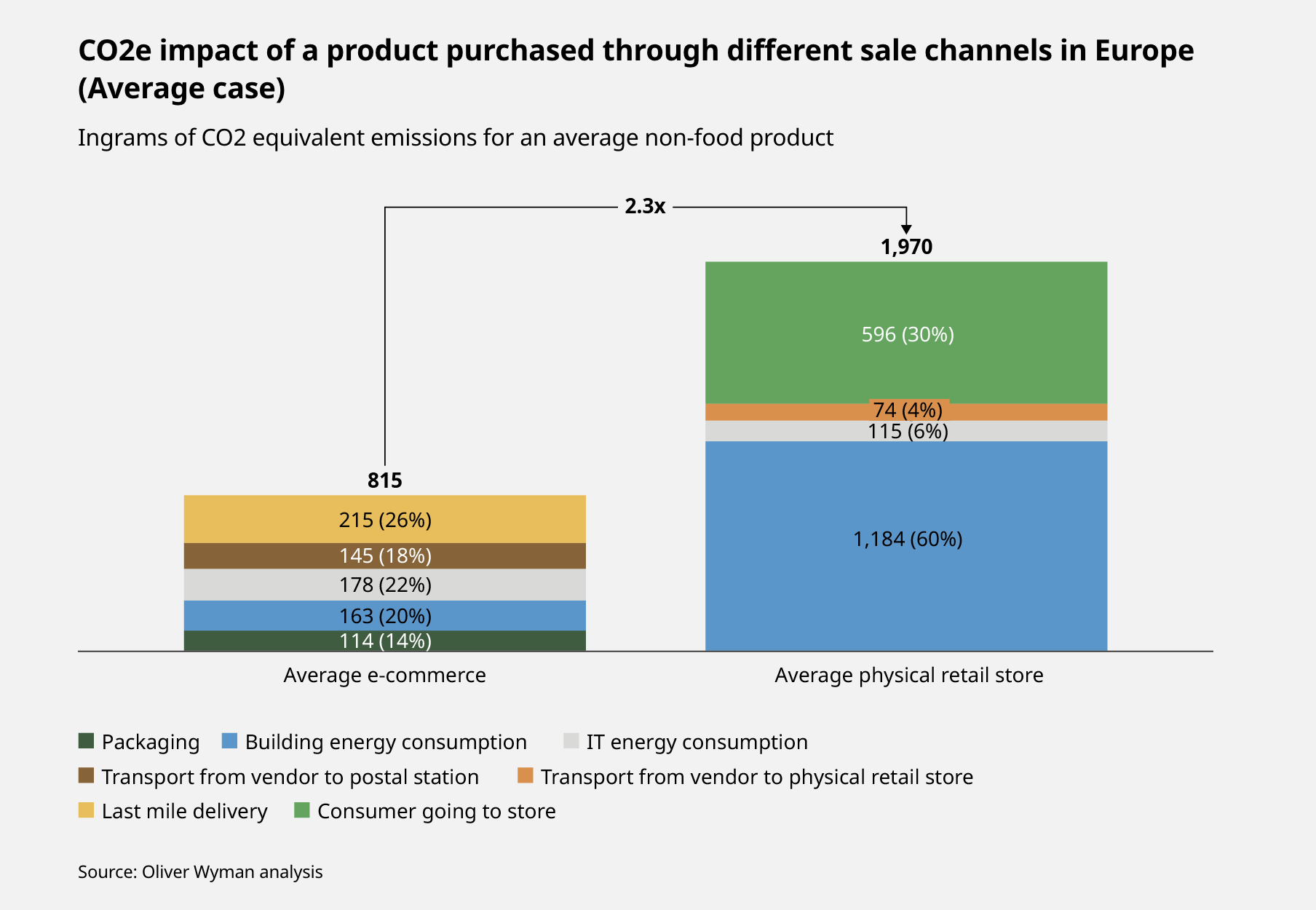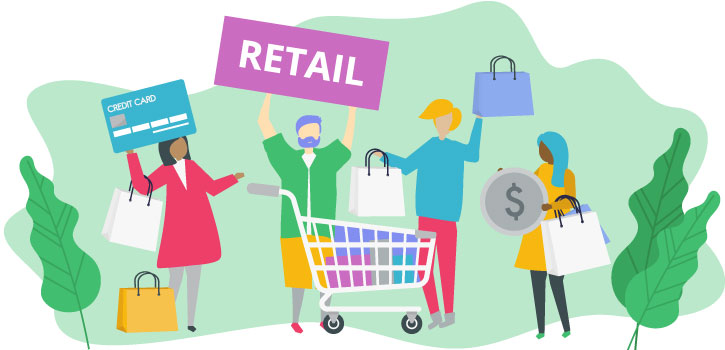Online retail versus physical stores: which is more harmful to the environment?
In 2023, global online retail sales reached approximately $5.8 trillion according to Statista. Now that’s a staggering figure! So it makes a lot of sense to think about the environmental aspect of online transactions. Are online stores more harmful to the environment than physical shops? Or is it the other way round? And how can we become more responsible consumers? Let’s find out the answers together.
What are the differences between physical retail and online retail?
These two marketing methods are very similar in that they both enable consumers to buy a product or service. The big difference lies in how buyers find and purchase their goods or services.
Before we decide which method is more environmentally friendly, it’s important to understand the main differences that separate them.
Accessibility
To make an online purchase, consumers only need a computer and an internet connection. To buy a product in a shop, they have to use a vehicle and find a parking space or take public transport. This means it’s more practical for consumers to shop online.
Operating costs
Managers of physical stores have to rent or buy premises, hire employees and also hire cleaning staff… Their operating costs are therefore much higher than an online retailer’s management costs. The latter simply has to pay for a hosting solution and a domain name.
Stock management
In a physical shop, stock is generally kept in a special room. And when a product is unavailable in a certain size, it is not immediately restocked. This can lead to customers becoming frustrated because they made the effort of physically travelling to the shop.
Online, it is possible to add a button so that internet users are automatically notified by email when a product is back in stock. This option is very popular with online users.
Shopping experience
Thanks to all the automation available to e-retailers, the online customer experience is improving constantly in quality. That said, the biggest difference between physical stores and online stores is that in a physical shop, you can try on products. This is very practical, particularly for jeans, glasses and underwear.
Interesting fact 💡
To address this shortfall, more and more online stores are offering customers virtual fittings (via VR).
Online retail versus physical stores: which is better for the environment?
The truth is that the environmental impact of physical stores differs greatly, largely depending on their managers.
For example, a shop that always hands out plastic bags free of charge to all its customers will have a much higher carbon footprint than a physical shop that charges 30 eurocents for paper bags. Some chains, such as Yves Rocher, have taken this a step further by doing away with bags altogether.
To get a better idea of the impact that physical stores have on the environment, let’s take a look at each source of pollution. Then we’ll do the same with online retail.
Physical stores
Travel to the shop
As we mentioned earlier, some customers have to travel a certain distance by car to visit physical stores and do their shopping in person, particularly those who don’t live near large towns. These trips by car, bus or taxi are a major source of pollution.
In-store energy consumption
Physical stores consume a lot of energy for heating, lighting and air conditioning, not to mention high-end boutiques that sometimes leave their lights on all night.
Bags for customers
In Europe, fewer and fewer physical stores are handing out free plastic bags to their customers. However, in other countries, such as the United States, it’s still common for stores to give out bags. This leads to over-consumption of plastic and high greenhouse gas emissions.
Online retail
Shipping and packaging
This is by far the most environmentally unfriendly element when you consider online retail’s carbon footprint. The packages and parcels that are sent sometimes contain plastic and are not always suited to the size of the product inside. A lot of transport is also required to ship these products.
Thankfully, there are various solutions that can make online retail more eco-friendly. For example, it’s possible to use recycled cardboard for the packaging and to choose the right size of parcel to avoid wasted materials. It’s also possible to opt for a delivery company that uses only electric vehicles.
Storage space
Although online retail companies don’t need physical premises to display their products, they still need to store them somewhere. They do this by using specialised warehouses. This is where orders placed by online customers are processed and dispatched. And these warehouses also need to be lit and heated. That said, they are often shared between multiple companies, which reduces the use of resources (electricity, heating).
Consumerism
It only takes a few clicks to order a product on the internet. And although this is very handy, it leads to the rise of consumerism: a mode of life based on consumption, verging on overconsumption.
What do the figures say?
According to a study carried out by Oliver Wyman in Germany, Spain, France, Italy, the Netherlands, Poland, Sweden and the UK, the CO² impact of an in-store purchase is 2.3 times greater than buying the same product online.

Please note that this analysis looks at:
- transport from the warehouse to the consumer (including transport to the shop)
- packaging
- energy consumption of buildings and IT tools for physical and online sales.
Another key finding of the study is that online retail deliveries to consumers account for 0.5% of total road traffic in urban areas, whereas physical retailing accounts for 11%.
How can you improve your shopping habits to become more environmentally friendly?
1. Choose sustainable, quality products
Wherever possible, it’s better to opt for responsible, sustainable products rather than fast fashion. Although these are generally cheaper to buy, they don’t last nearly as long. So, it’s win-win if you go for sustainable, quality products instead!
2. Support responsible companies
Another best practice for developing greener shopping habits: support ethical brands. In fact, some brands are making a huge effort to adopt sustainable and ethical practices. It’s very important to support them and help promote responsible consumption.
But beware of greenwashing! It’s vital to do your own research into what companies actually do, rather than relying on sometimes misleading marketing slogans.
3. Reduce your waste
As a consumer, you can compost your waste, sort and recycle as much as possible. For example, you can keep all your product packaging so that you can reuse it when you sell a product yourself, on Vinted for example.
4. Plan your purchases
We advise you to plan your purchases and avoid compulsive shopping to cut down on waste. For example, when you go shopping, you can take a list with you. This means you only buy what you actually need.
5. Consider Click & Collect
Nowadays, many stores offer their customers the option of ordering their goods online and collecting them in-store. This is called Click & Collect and is a more environmentally-friendly option.
It avoids the unnecessary emissions caused by shipping online retail parcels, and means that you can get your products quickly, without having to wait 3 to 5 days for them to arrive at your home.
The best practices for online retailers consist of:
- making products that last;
- avoiding greenwashing;
- reducing packaging and the production of plastic products;
- enabling customers to plan their purchases (e.g. setting up a subscription system, a customer account with lists of favourites, etc.);
- implementing a Click & Collect
Online retail versus physical stores: the verdict
The verdict is in! The CO² impact of an in-store purchase is 2.3 times greater than buying the same product online. But be warned, this depends on many factors, and the most important thing for the buyer is to make sure that the brands they choose are environmentally friendly.
It will help you to look at:
- where the products come from;
- the ingredients or materials used (e.g. vegan bags, cruelty-free beauty products, recycled materials promoting the circular economy,
- packaging materials and size;
- whether refills are available, etc.
In fact, many brands now offer refills so that less plastic is used. This is particularly true of the Respire brand, which sells deodorant refills that are much smaller than the original products.
For more information, we suggest reading our article on the impact of online retail on the environment.







